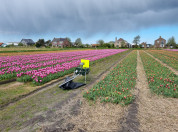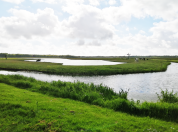Droevendaalsesteeg 10
6708 PB Wageningen
The Netherlands
Most of my career I have been working on modelling processes in aquatic ecosystems and developing tools for water quality management. Recently, I got involved in a Living Lab for biodiversity recovery in Dutch agricultural areas with focus on bulb culture.
After having worked on fish ecology during my PhD and the individual-based modelling of animal populations during the first fifteen years of my stay at NIOO, my research interest gradually evolved into my current focus on social-ecological interactions in both aquatic and terrestrial ecosystems in the context of the Anthropocene. My first interest in this type of research arose during my collaboration with Dr Andrea Downing (now working at the Stockholm Resilience Centre) during her PhD project the social-ecological consequences of the Nile Perch invasion of Lake Victoria. Thereafter, this line of research expanded during my collaboration with Dr. Jan Kuiper (now also working at the Stockholm Resilience Centre), Dr. Luuk van Gerven (now at Wageningen Environmental Research) and Dr Annette Janssen (now at Wageningen University) on social-ecological studies on eutrophication of surface waters in the Netherlands (funded by Stowa) and China (funded by NWO) and continues in my collaboration with Manqi Chang (funded by the CSC). With Dianneke van Wijk MSc, Lilith Kramer MSc, Hilde Vaessen MSc en Dr Sven Teurlincx I work on the interaction of water quality and nutrient retention in networks of surface waters with the aim to turn these systems into Smart Nutrient Retention Networks. This work is funded by WUR, NWO and four water boards. Part of this work takes place in the area of Nationaal Park Hollandse Duinen, a new style National Park in the Netherlands that aims to identify, protect, restore and enhance the high quality of the Dutch coastal landscape. Currently, I am applying for funding to expand my work in the area of Nationaal Park Hollandse Duinen to synergistically combine fundamental social-ecological research with area-oriented studies.
Nutrient pollution of surface waters contributes to eutrophication problems and constitutes a loss of valuable resources for human food production. Nutrient retention in lakes prevents part of this loss and downstream pollution, and depends on the ecosystem state (e.g., macrophyte-dominated shallow lakes having higher phosphorus retention than phytoplankton-dominated shallow lakes). We developed a relatively simple and versatile model of nutrient retention in relation to ecosystem state in shallow lakes: GPLake-R. Here the "GP" stands for "generically parameterized" and “R” stands for “retention”. We build on the GPLake-M model that describes equilibrium macrophyte and phytoplankton abundance in shallow lakes in response to nutrient loading, by adding the ecologically relevant options for co-limitation of nutrients and light in macrophytes and phytoplankton and coexistence of macrophytes and phytoplankton around critical nutrient loadings. In this approach we combined insights from resource competition theory while adhering to the principle of mass conservation. As an outcome, GPLake-R gives a single equation for phosphorus retention in relation to ecosystem state that captures the hysteretic pattern from the more complex PCLake model. GPLake-R has a strong educational potential and can serve as a building block to illustrate the effect of water quality and nutrient retention management strategies in networks of shallow lakes. Moreover, we found that the co-limitation and coexistence processes in GPLake-R generally lessen nutrient retention, which could lead to higher downstream nutrient pollution than expected based on earlier approaches. Therefore, we conclude that it is important to consider resource co-limitation and species coexistence when developing novel water quality management strategies for interconnected water systems.
Designing effective management strategies for lake networks is challenging as nutrient dynamics within a lake can be complex and nonlinear, and potentially cause spatial cascades. The recently developed lake meta-ecosystem model PCLakeS+ can aid in finding such management strategies. Here, we present the first real-world application of PCLakeS+ on the Frisian Lake Network, a lake meta-ecosystem located in the North of the Netherlands. We aim to 1) evaluate the performance of the PCLakeS+ model against empirical data, and 2) explore the long-term impacts of an experimental flushing scheme on the lake ecosystem status and network wide nutrient retention of the Frisian Lakes. We showed that model performance fitted reasonably well with measured water quality indicators in the lake, especially given uncertainties in water flows. We found that deriving the required water flows to simulate a meta-ecosystem network was not easily accomplished in relatively complex and heavily managed lake networks, even though a detailed hydrodynamic model was available. In terms of management, we found that the long-term application of the flushing scheme alone would not suffice to initiate an ecosystem state change to a clear, macrophyte dominated system in all lakes but one. Rather, we found that the flushing scheme would increase the nutrient transport towards the Northern regions of the system, as nutrient retention capacity of the lakes in the network was limited. Our lake network model application revealed the importance of additional management measures to achieve desirable environmental outcomes in the Frisian Lake Network.
Lakes fulfill essential functions for people and nature, but at the same time are being heavily impacted by human pressures and the climate in this era. In this study we modeled the impact of three surface water abstraction rates in the epilimnion for drinking water purposes in combination with climate change on the ecological quality and the recreational potential of a quarry lake in The Netherlands. Our results show that the highest surface water abstraction rate (1.36 m3/s) - related to the estimated abstraction rate for 2040 - would substantially change the ecological quality of the lake. Specifically, this surface water abstraction rate caused a threefold extension of the period of hypoxia in the hypolimnion and a reduction of the phytoplankton summer bloom as compared to the baseline. Simultaneously, the reduction of cyanobacteria in the lake due to the surface water abstraction would improve the lake's suitability for recreation, as the risk of harmful blooms becomes negligible. The two lower surface water abstraction rates showed results in between the no-abstraction and the high abstraction rate results. When considering only the changes in the climate between 2010 and 2050, we found that the lake's ecological quality would decrease, mainly due to prolonged hypoxic conditions. However, the recreational potential remained relatively unchanged due to climate change. Overall, our findings indicate that surface water abstraction, in particular at the highest rate, would have a more profound impact on the lake than the projected climate change. Our study highlights the importance of including local water management strategies, such as surface water abstractions, in future water quality simulations.
Worldwide, water quality managers target a clear, macrophyte-dominated state over a turbid, phytoplankton-dominated state in shallow lakes. The competition mechanisms underlying these ecological states were explored in the 1990s, but the concept of critical turbidity seems neglected in contemporary water quality models. In particular, a simple mechanistic model of alternative stable states in shallow lakes accounting for resource competition mechanisms and critical turbidity is lacking. To this end, we combined Scheffer's theory on critical turbidity with insights from nutrient and light competition theory founded by Tilman, Huisman and Weissing. This resulted in a novel graphical and mathematical model, GPLake-M, that is relatively simple and mechanistically understandable and yet captures the essential mechanisms leading to alternative stable states in shallow lakes. The process-based PCLake model was used to parameterize the model parameters and to test GPLake-M using a pattern-oriented strategy. GPLake-M's application range and position in the model spectrum are discussed. We believe that our results support the fundamental understanding of regime shifts in shallow lakes and provide a starting point for further mechanistic and management-focused explorations and model development. Furthermore, the concept of critical turbidity and the relation between light-limited submerged macrophytes and nutrient-limited phytoplankton might provide a new focus for empirical aquatic ecological research and water quality monitoring programs.
Water quality improvement to avoid excessive phytoplankton blooms often requires eutrophication management where both phosphorus (P) and nitrogen (N) play a role. While empirical eutrophication studies and ecological resource competition theory both provide insight into phytoplankton abundance in response to nutrient loading, they are not seamlessly linked in the current state of eutrophication research. We argue that understanding species competition for multiple nutrients and light in natural phytoplankton communities is key to assessing phytoplankton abundance under changing nutrient supply. Here we present GPLake-S, a mechanistic model rooted in ecological resource competition theory, which has only eight parameters and can predict chlorophyll-a to nutrient relationships for phytoplankton communities under N, P, N+P colimitation and light limitation. GPLake-S offers a simple mechanistic tool to make first estimates of chlorophyll-a levels and nutrient thresholds for generic lake properties, accounting for variation in N:P ratio preferences of phytoplankton species. This makes the model supportive of water management and policy.






